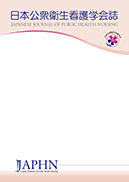Volume 7, Issue 2
Displaying 1-6 of 6 articles from this issue
- |<
- <
- 1
- >
- >|
Foreword
-
2018 Volume 7 Issue 2 Pages 59
Published: 2018
Released on J-STAGE: August 27, 2018
Download PDF (488K)
Research Article
-
Article type: Research Article
2018 Volume 7 Issue 2 Pages 60-71
Published: 2018
Released on J-STAGE: August 27, 2018
Download PDF (398K) Full view HTML -
Article type: Research Article
2018 Volume 7 Issue 2 Pages 72-79
Published: 2018
Released on J-STAGE: August 27, 2018
Download PDF (336K) Full view HTML -
Article type: Research Article
2018 Volume 7 Issue 2 Pages 80-90
Published: 2018
Released on J-STAGE: August 27, 2018
Download PDF (481K) Full view HTML -
Article type: Research Article
2018 Volume 7 Issue 2 Pages 91-99
Published: 2018
Released on J-STAGE: August 27, 2018
Download PDF (372K) Full view HTML
Public Health Nursing Report
-
Article type: Public Health Nursing Report
2018 Volume 7 Issue 2 Pages 100-107
Published: 2018
Released on J-STAGE: August 27, 2018
Download PDF (369K) Full view HTML
- |<
- <
- 1
- >
- >|
